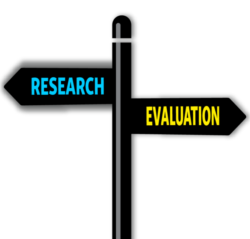The distinction between research and evaluation is often not clear.
Investigators should review the Department of Health and Human Services (HHS) Guidelines and consult with the cognizant IRB for guidance on their project. In brief, there are two considerations: is it research or evaluation and are human subjects involved.
What type of study are you conducting
- Research or evaluation? Research is an investigation undertaken in a systemic way to contribute to generalizable knowledge; the analyzed results are “generalizable” to practices outside the program and organization undertaking the project. The intent of a research project is to test hypotheses about the relationship between an intervention and outcomes. Other organizations or individuals may benefit from the information learned and analysis provided. can be as rigorously structured as research, but the results are limited to a specific program and project. The purpose of an evaluation is to assess the efficacy of a specific project for internal organizational use to inform future decisions about program .
- Are human subjects involved? Research and evaluation projects may both observe humans to obtain data. Whether they are “human subjects” for the purpose of research depends on multiple factors. One of which is whether or not the investigator obtains information by interacting directly with living human beings. For example, if an investigator observes people using a park to evaluate patterns of use but does not interact with them directly to ask questions, they are not subjects. However, if the investigator stops people and asks them to complete a questionnaire, then they become human subjects.
Additional Considerations for Research or Evaluation
NEEDS OF YOUR PROJECT Your project and community should consider: What is the outcome that you are trying to achieve? What is the question you need to answer? Who are you trying to influence? What is your timeline, budget and level of certainty needed? The bank of survey questions presented in this guide provide a range of possible information to gather yet are not intended to be a prescribed list of tools. What you choose to use will depend on the questions you seek to answer and who needs the information. For instance, one team in your organization may want certain information about how nature benefits the user of a greenspace, while another team is trying to inform a policy.
SAMPLE SIZE The sample size will depend on the study or target population and data analysis you will perform. Once you know basic details about the population of interest, there are online resources to help determine sample size. If necessary, there are also online resources available to assist with “power analysis” so that you have an adequate sample size to detect differences. Many survey platforms (e.g. Survey Monkey, Qualtrics) provide sample size calculators to help you determine your sample size.
RECRUITMENT It may be necessary to recruit participants, especially participants who are representative of the current or future population impacted by the green intervention, to evaluate the effect of your project. Note that asking people to “volunteer” to participate in surveys can inadvertently favor one group of potential respondents over another. Consider providing incentives or compensation to your participants.
INCENTIVES The use of incentives to compensate participants is common and is considered an acceptable practice. Any payment for participation in your research should be fair and just, (e.g., time spent or loss of wages plus reimbursement for reasonable travel and lodging expenses) without undue influence. In addition to monetary payments such as cash, gift cards, certificates, or vouchers, incentives and compensation can be offered in nonmonetary forms such as promotional items.


